This is How We Roll
 Most of us strain our upper backs habitually. Whether we’re slumping forward with our shoulders and head, or exaggeratedly pulling our shoulders back, we irritate the rhomboid attachments in the thoracic spine (upper back). The spinal muscles, either from being overstretched or overstrained, become “knotty” and sore.
Most of us strain our upper backs habitually. Whether we’re slumping forward with our shoulders and head, or exaggeratedly pulling our shoulders back, we irritate the rhomboid attachments in the thoracic spine (upper back). The spinal muscles, either from being overstretched or overstrained, become “knotty” and sore.
Additionally, to the extent that the upper back becomes stiff or even rigid from habitual hunching, it is challenging to stretch and mobilize the regions that most need attention. As with a rusty bicycle chain, stiff areas tend to remain stiff, and mobile areas compensate and become hypermobile.
If this description fits you, it may be time for a back roller (Gokhale Method approved!)
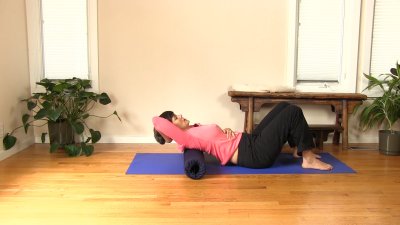 After years of experimenting with different types of rollers, I decided to design a roller after my own back. Here’s what I’ve come up with:
After years of experimenting with different types of rollers, I decided to design a roller after my own back. Here’s what I’ve come up with:
- An ideal roller needs to have a strong, hard core. There’s only so much give I want my roller to have. It’s the roller’s job to push back against my tight back and not bend out of shape (or worse, remain out of shape) when I lie on it.
- It needs to be comfortable, which means having a soft padded exterior. Pressure is good, but brutal pressure can bruise the back and feel plain uncomfortable, especially if you don’t have a lot of built-in padding.
- It needs to be at least one foot wide to support my torso, but not so wide that my hands won’t be able to reach the floor on either side of the roller when I roll / massage my sacrum.
- I would prefer for the material to not skid on my wooden floor or on my body. I used PU foam rather than EVA foam that most rollers are made from. EVA foam is too slippery. This means taking a small hit on how new the roller is going to look after use - well worth it in my view.
- I would prefer the roller to be light for travel. This means the hard inner core needs to be made of ABS rather than PVC tubing (the more common cheaper heavy material some rollers are made from)
- The central hard core should not slip out and crush my toes (been there, done that) when carrying the roller.
- I don’t want anything gimmicky like patterns on the roller - in my experience, little squares and rectangles carved into the roller’s surface don’t really translate into finger or thumb-type pressure but rather make for bumpy rolling.
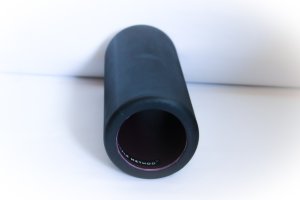
So there it is: ABS core (hard yet light), molded PU foam (soft but not too slippery), molded-over edges (prevents the core slipping out), one foot wide, plain exterior. It’s called the Gokhale Roller and we’re launching it today. We only have 1000 units - depending on your feedback, we will order more and make it a staple offering.
Directions:
- Sit on the floor with your knees bent. Place the foam roller behind you, perpendicular to your torso. Lie back on the foam roller. Adjust it so that the roller is even with your shoulder blades.
- Raise your butt up so that your weight is supported somewhat by your feet and mainly by the foam roller. Keep your elbows close together in front of your face. This gets your shoulder blades out of the way, exposing the tight muscles you really want to work. Move your hips up and down to roll along your upper back. You will notice that, to maximize your weight on the roller, your hips need to be elevated when you are working high up in the spine; when you are rolling your back lower in the thoracic area, the hips descend almost to the ground.
- While rolling out your back, your arms want to gently elongate your neck. At no point do the neck and back distort significantly from their original shape.
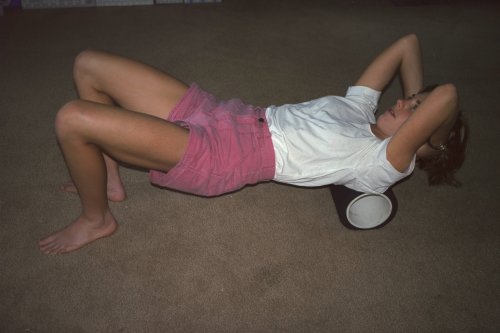
My student Merrill Page rolling out her upper thoracic spine.
Note her elbows ahead of her face and her arms gently elongating her neck.
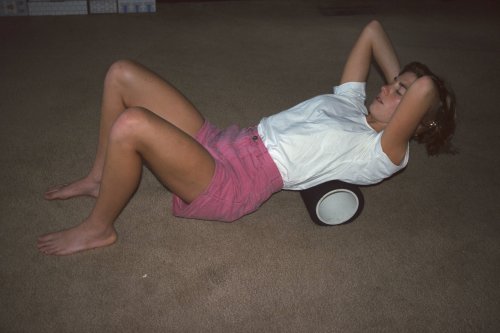
Mid-back rolling
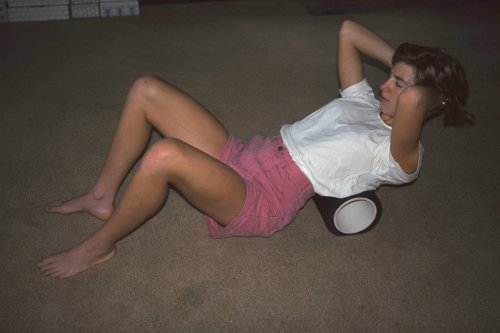
Rolling out the lower thoracic spine - note Merrill's bottom is almost on the ground.
The back and neck remain approximately the same shape throughout the exercise.

Back rolling helps keep your upper back upright and lovely!
Best,
Esther
Join us in an upcoming Free Workshop (online or in person).
Find a Foundations Course in your area to get the full training on the Gokhale Method!
We also offer in person or online Initial Consultations with any of our qualified Gokhale Method teachers.

Comments
Are there any modifications,
Are there any modifications, or other tools that would have the same effect, for people with osteopenia or osteoporosis?
Thanks for any suggestions.
Sandy
You want to load less weight
You want to load less weight on the area you are working on - work with a less horizontal surface (e.g. padded edge of a massage table), maybe even a vertical surface (e.g. wall with object protruding). But do check with your doctor about how much weigth makes sense for you.
I discovered I can stretch my
I discovered I can stretch my hunched upper back by just laying on my back on the floor. This seems to work best with my knees bent, and to protect my neck I rest my head on a book of suitable thickness. For me, a book about 1 - 1.5 inch thick works ok. Then I just relax and listen to music or a radio station. Does this kind of stretch sound ok or am I harming myself somehow? I also roll my back daily on a Gokhale roller.
This sounds like it works
This sounds like it works well for you.
Would you ever consider
Would you ever consider making a standard length roller (about 3 ft)? I like to use them for my hamstrings and don't think a 13" roller would work for that. I also lie on it lengthwise and do snow angels and other PT-suggested exercises.
Add New Comment
Login to add commment
Login